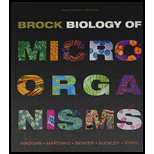
Brock Biology of Microorganisms, MasteringMicrobiology with eText and Access Card (14th Edition)
14th Edition
ISBN: 9780133857276
Author: Michael Madigan
Publisher: PEARSON
expand_more
expand_more
format_list_bulleted
Concept explainers
Question
Chapter 17.11, Problem 1MQ
Summary Introduction
Chytridiomycota which are also called chytrids contain unusual motile spores called zoospores. These zoospores are flagellated and differentiate the members of chytridiomycota from rest members of
Expert Solution & Answer
Want to see the full answer?
Check out a sample textbook solution
Students have asked these similar questions
What animal group has been most affected by chytrids?
What are the main human diseases caused by roundworms?
What are the peculiar features that you find in parasitic platyhelminthes?
Chapter 17 Solutions
Brock Biology of Microorganisms, MasteringMicrobiology with eText and Access Card (14th Edition)
Ch. 17.1 - Prob. 1MQCh. 17.1 - Prob. 2MQCh. 17.1 - Prob. 3MQCh. 17.2 - Prob. 1MQCh. 17.2 - Prob. 2MQCh. 17.2 - Prob. 3MQCh. 17.3 - Prob. 1MQCh. 17.3 - Prob. 2MQCh. 17.4 - Contrast the two nutritional options for Euglena.Ch. 17.4 - Prob. 2MQ
Ch. 17.4 - Prob. 3MQCh. 17.5 - Prob. 1MQCh. 17.5 - Prob. 2MQCh. 17.5 - What are apicoplasts, which organisms have them,...Ch. 17.6 - Prob. 1MQCh. 17.6 - Prob. 2MQCh. 17.6 - Prob. 3MQCh. 17.7 - Prob. 1MQCh. 17.7 - How are chlorarachniophytes thought to have...Ch. 17.8 - Prob. 1MQCh. 17.8 - Compare and contrast the lifestyles of gymnamoebas...Ch. 17.8 - Prob. 3MQCh. 17.9 - What are conidia? How does a conidium differ from...Ch. 17.9 - Prob. 2MQCh. 17.9 - Prob. 3MQCh. 17.10 - Why is the mold Penicillium economically...Ch. 17.10 - Prob. 2MQCh. 17.10 - Prob. 3MQCh. 17.11 - Prob. 1MQCh. 17.11 - Prob. 2MQCh. 17.11 - Prob. 3MQCh. 17.12 - Prob. 1MQCh. 17.12 - Prob. 2MQCh. 17.12 - Prob. 3MQCh. 17.13 - Prob. 1MQCh. 17.13 - Prob. 2MQCh. 17.14 - Prob. 1MQCh. 17.14 - Prob. 2MQCh. 17.15 - What traits link cyanobacteria and red algae?Ch. 17.15 - Prob. 2MQCh. 17.16 - What phototrophic properties link green algae and...Ch. 17.16 - What is unusual about the green algae...Ch. 17.16 - Prob. 3MQCh. 17 - Prob. 1RQCh. 17 - Prob. 2RQCh. 17 - Prob. 3RQCh. 17 - Prob. 4RQCh. 17 - Prob. 5RQCh. 17 - Three groups make up the alveolates: ciliates,...Ch. 17 - Prob. 7RQCh. 17 - REVIEW QUESTIONS
8. What morphological trait...Ch. 17 - Prob. 9RQCh. 17 - Prob. 10RQCh. 17 - Prob. 11RQCh. 17 - Prob. 12RQCh. 17 - Prob. 13RQCh. 17 - Prob. 14RQCh. 17 - Prob. 15RQCh. 17 - Prob. 16RQCh. 17 - Green algae are common in aquatic environments and...Ch. 17 - Explain why the process of endosymbiosis can be...Ch. 17 - Summarize the evidence for endosymbiosis. How...
Knowledge Booster
Learn more about
Need a deep-dive on the concept behind this application? Look no further. Learn more about this topic, biology and related others by exploring similar questions and additional content below.Similar questions
- What are the best known representatives of the platyhelminth phylum?arrow_forwardIn Platyhelminthes, what are the advantages/disadvantages of being a parasite? Free living? Why is there an observed loss of organs and structures in parasitic species?arrow_forwardApicomplexans are widespread and common parasites of worms, echinoderms, insects, and vertebrates (including humans). What characteristics do these protozoans have that make them highly infective (efficient as parasites)?arrow_forward
- How do Schistosoma japonicum differ from other trematodes? How is the Schistosomiasis diagnosed? What are the clinical manifestations of a person affected with the adult or larval tapeworms?arrow_forwardWhat are some of the roundworm infections that can occur in humans and how can they be they transmitted? Describe the symptoms.arrow_forwardWhat are the unifying characteristics of Sardinella tawilis under the following taxonomic ranks: Class - Actinopterygii — Order - Clupeiformes —arrow_forward
- Why are termites essential members of communities in nature? How do they alter habitats?arrow_forwardWhat class under Platyhelminthes contains proglottis ? a)Nematoda b) cestoda c) plasmodium d)flukesarrow_forwardWhy are the larvae of Trichinella spiralis considered more dangerous than the adults?arrow_forward
arrow_back_ios
SEE MORE QUESTIONS
arrow_forward_ios
Recommended textbooks for you
 Biology: The Dynamic Science (MindTap Course List)BiologyISBN:9781305389892Author:Peter J. Russell, Paul E. Hertz, Beverly McMillanPublisher:Cengage Learning
Biology: The Dynamic Science (MindTap Course List)BiologyISBN:9781305389892Author:Peter J. Russell, Paul E. Hertz, Beverly McMillanPublisher:Cengage Learning


Biology: The Dynamic Science (MindTap Course List)
Biology
ISBN:9781305389892
Author:Peter J. Russell, Paul E. Hertz, Beverly McMillan
Publisher:Cengage Learning
